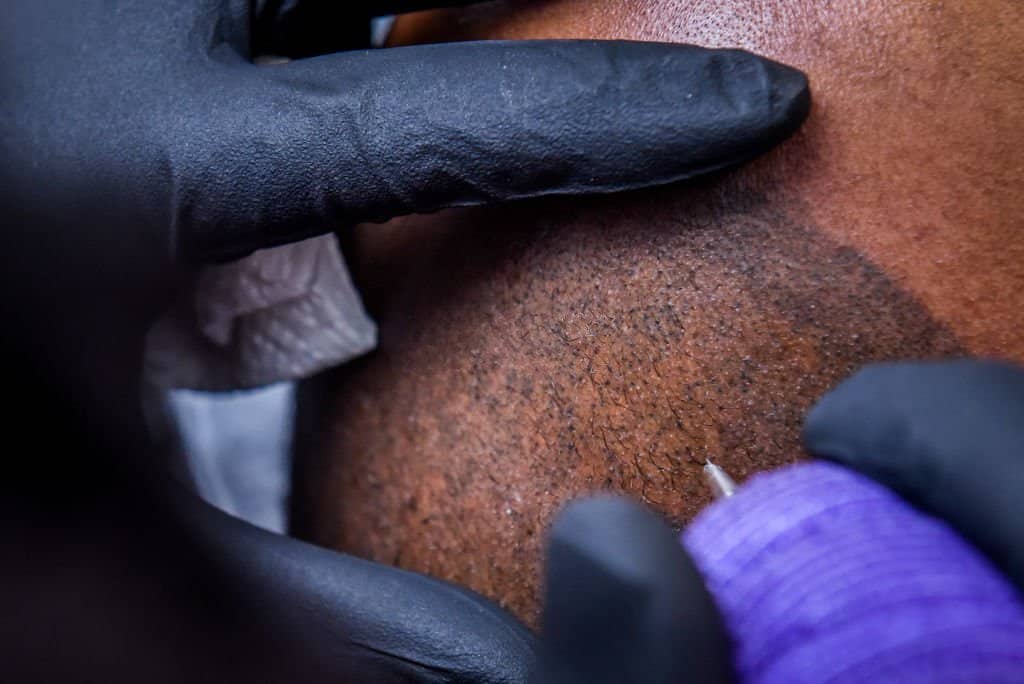Scalp micropigmentation is a hair restoration technique. But it’s not simple to remove. It requires laser treatments to break down the pigments. The number of sessions depends on pigment color and depth. Removal also depends on skin type and healing ability.
John was one such person. He wanted scalp micropigmentation, but then he changed his mind. He consulted a specialist who recommended laser treatments. He went through several sessions and waited for the pigments to fade away. After months, he achieved significant reduction – though traces remained. His appearance started returning to how it was before.
What is scalp micropigmentation?
Scalp micropigmentation is a revolutionary procedure to treat hair loss and baldness. Tiny pigments are tattooed onto the scalp to create the illusion of hair follicles and a fuller head of hair. It’s suitable for both men and women and gives long-lasting results.
The process starts with a consultation. The technician looks at the client’s hair color, skin tone, and desired outcome. Specialized equipment is used to inject pigments into the scalp via microneedles – matching the person’s natural hair color.
Unlike regular tattoos, scalp micropigmentation requires multiple sessions. Each session builds up the density and depth of the scalp. There’s minimal discomfort during the application.
One of the key advantages of scalp micropigmentation is that it’s permanent. The pigments don’t fade or alter much over several years. But, as with any cosmetic procedure, results may vary.
People might want to reverse or remove their scalp micropigmentation. Complete removal is hard due to how the pigments integrate with the skin. But laser tattoo removal can be used in some cases to lighten or partially remove scalp micropigmentation. This can take a while and may need multiple sessions.
Pro Tip: Research technicians’ qualifications and experience before getting scalp micropigmentation. No matter how much you regret it, there’s no Ctrl + Z for a scalp tattoo.
Can scalp micropigmentation be reversed or removed?
Scalp micropigmentation – a popular solution for hair loss or thinning – may be reversed or removed. Laser tattoo removal is one method, using laser technology to break down the pigments in the scalp. It may require multiple sessions and be uncomfortable.
Microneedling is another option. Tiny needles stimulate collagen production and fade pigments over time. This non-invasive procedure has no downtime. The removal process may not completely erase all traces of the treatment. A shadow or residue may remain visible. But lightening or fading the appearance can be achieved.
John opted for scalp micropigmentation but later wanted to remove it. He had several sessions of laser tattoo removal. There was some discomfort, but he was satisfied with the results. The pigments gradually faded, and no visible signs of the treatment remained.
Before taking action, consider your pain tolerance, number of sessions, and dedication to convince people you’re not joining a hair regrowth cult.
Factors to consider before deciding to reverse or remove scalp micropigmentation
Scalp micropigmentation involves tattooing tiny dots on the scalp to imitate hair follicles. But some may want to erase or reverse it in the future. It’s important to think it through before taking action.
Here are 4 things to consider:
- 1) Results: Evaluate if the treatment has made the desired impact and if it still agrees with your preference.
- 2) Motivation: Understand why you want to undo it, ensure your reasons are authentic and not based on temporary factors.
- 3) Alternatives: Explore other options like laser removal or camouflaging techniques which can lighten the pigmented areas without completely removing them.
- 4) Reversibility: Remember that scalp micropigmentation is semi-permanent and might fade naturally over time. Waiting for natural fading could be a better option than attempting removal.
Talk to a qualified professional to get personalized advice. Laser removal treatments can lessen scalp micropigmentation safely, according to a study in the Journal of Cosmetic Dermatology. So, if you’re ready to reverse your ‘permanent’ hair tattoo, get ready for scalp micropigmentation removal!
Preparing for scalp micropigmentation removal
Anna’s story is a great example of what it takes to be prepared for scalp micropigmentation removal.
When considering such a procedure, it’s important to:
- Consult with a professional technician.
- Manage expectations.
- Understand risks and side effects.
- Consider financial implications.
Open communication is key to achieving the best results. Permanent marker tattoos can be taken to the next level with scalp micropigmentation – thankfully, there’s a removal process for those who change their mind!
The scalp micropigmentation removal procedure
Scalp micropigmentation removal can undo the effects of scalp micropigmentation. Here’s the scoop:
- 1. Lasers are a popular option for this procedure. They break down the pigments in the scalp, allowing the body to absorb them and make them fade away.
- 2. The number of laser sessions needed to totally remove the pigments depends on factors like their size and depth, and your skin type. You may need multiple sessions.
- 3. It’s important to know that complete removal can’t always be guaranteed. Some pigments may be tougher to remove or may need more treatments.
If you’re considering scalp micropigmentation removal, chat with a specialist. This could be your chance to switch up your look and get back your confidence. Don’t wait – book an appointment now and take the first step!
Post-removal considerations and potential outcomes
For those looking to reverse or remove scalp micropigmentation, there’s an escape hatch! Here’s what you need to know: seek professional help. A trained technician or dermatologist can guide you through the process and provide expert advice. It’s not an instant fix, though; it could take multiple sessions over a period of time, with potential side effects like redness, swelling, or scabbing. Different skin types may respond differently, so make sure to consult with a professional. Plus, the outcome may vary based on individual factors. Lastly, follow aftercare instructions to ensure optimal healing. So, if you regret your sketched-on scalp, don’t worry – permanent can still have an expiry date!
Conclusion
Scalp micropigmentation is permanent. It can’t be reversed or taken away without doing other things. This is because the pigments are built to last and are hard to remove.
If someone wants to remove or change their scalp micropigmentation, they have some choices. One is laser tattoo removal. This can help fade the pigments after multiple treatments. But, it might not be possible to take it away completely and there may still be some left over.
Another option is to get more treatments to hide or alter the existing pigments. This could help you get the look you want without taking away the old work.
It’s essential for people thinking of scalp micropigmentation to understand that it’s permanent. There are options for changing or taking away, but it could be hard and expensive. It may take time and be uncomfortable.
Frequently Asked Questions
Q: Can scalp micropigmentation be reversed or removed if desired?
A: Yes, scalp micropigmentation can be reversed or removed if desired. There are various methods available to remove or alter the pigmented areas, including laser treatments, chemical removal, and dermabrasion. It is important to consult with a professional to determine the most suitable method for your specific case.
Q: Is scalp micropigmentation removal painful?
A: The pain level during scalp micropigmentation removal may vary depending on the method chosen. Laser treatments and chemical removal typically involve some discomfort, which can be managed with numbing creams or local anesthesia. Dermabrasion may require local anesthesia for numbing the scalp. However, the level of pain experienced is typically bearable and well-tolerated by most individuals.
Q: How long does it take to remove scalp micropigmentation?
A: The duration of scalp micropigmentation removal depends on several factors, including the size and density of the treated area, as well as the method chosen for removal. Laser treatments may require several sessions spread over weeks or months, while chemical removal and dermabrasion usually involve a single session. The overall process can take anywhere from a few weeks to several months.
Q: Are there any risks or side effects associated with scalp micropigmentation removal?
A: While scalp micropigmentation removal is generally safe, there can be some risks and side effects. These may include temporary skin discoloration, swelling, scarring, and irritation. By choosing a experienced professional and following proper aftercare instructions, the risks and side effects can be minimized.
Q: How much does scalp micropigmentation removal cost?
A: The cost of scalp micropigmentation removal can vary depending on factors such as the size of the treated area, the method chosen, and the location of the treatment facility. Generally, laser treatments tend to be more expensive than chemical removal or dermabrasion. It is advisable to consult with a professional to get an accurate cost estimate based on your specific needs.
Q: Is scalp micropigmentation removal covered by insurance?
A: In most cases, scalp micropigmentation removal is considered a cosmetic procedure and is not covered by insurance. However, it is recommended to check with your insurance provider to determine if they offer any coverage or reimbursement for the removal procedure.


